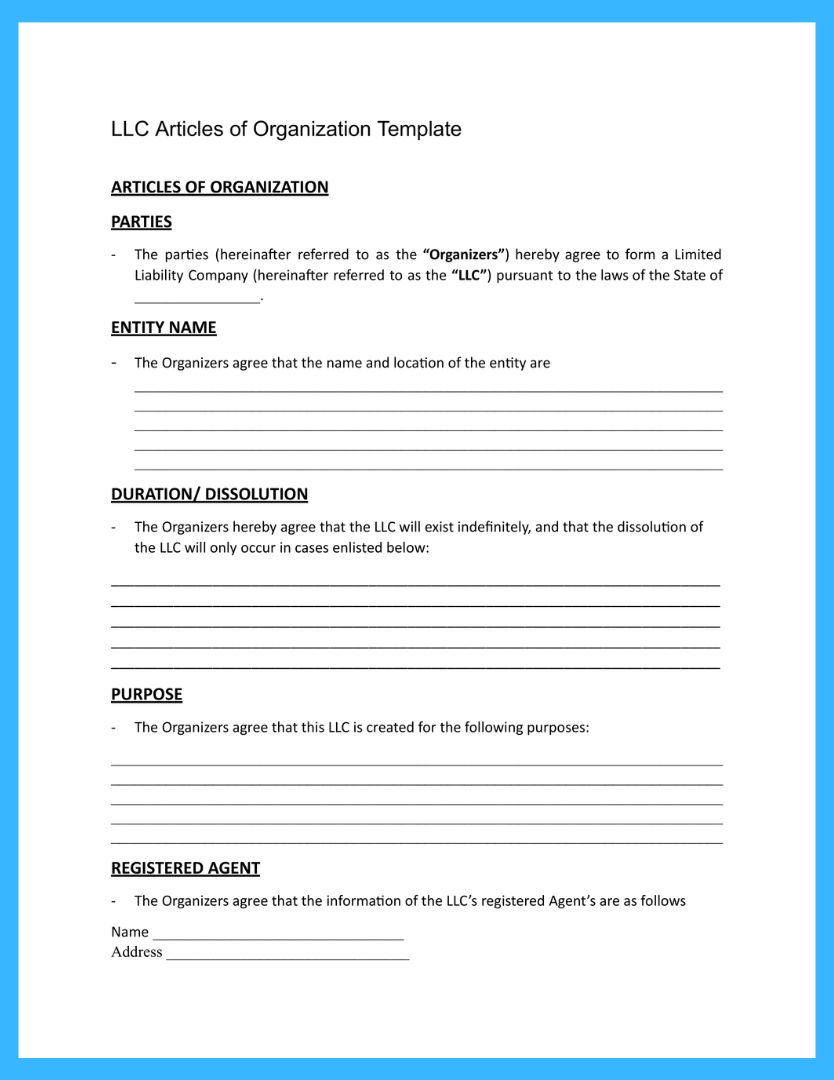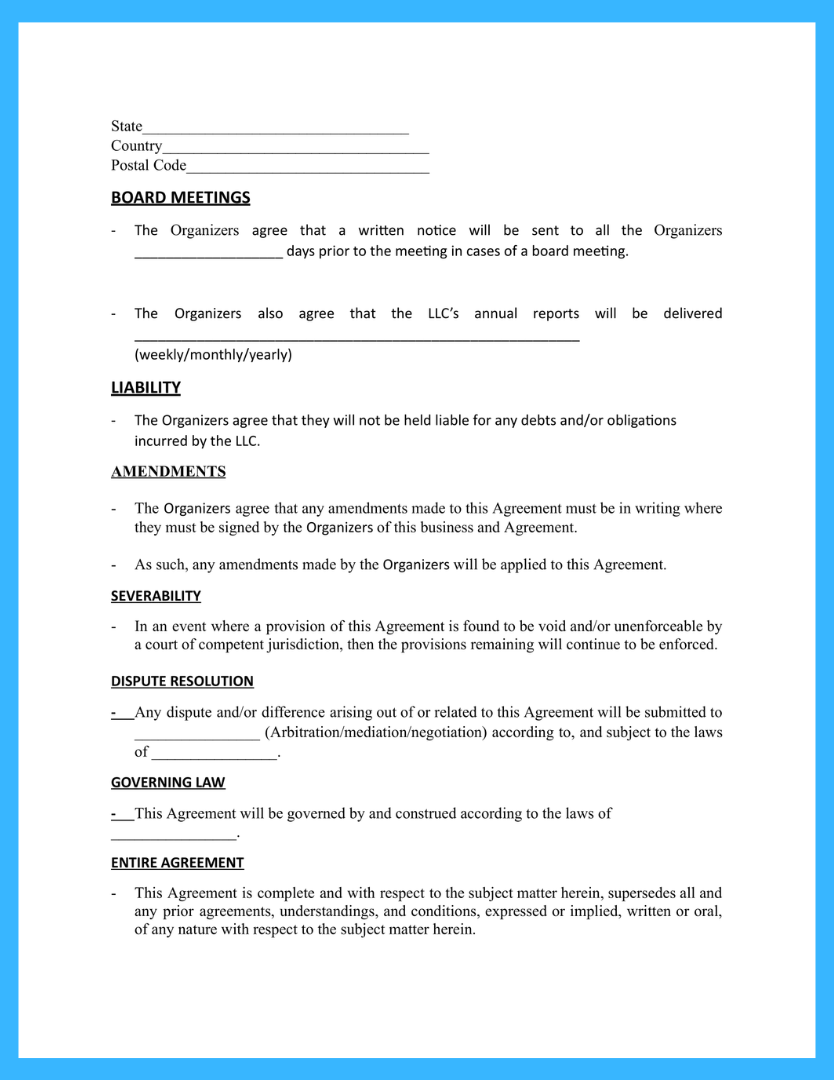
The journey of starting an LLC can be thrilling but can also seem like a maze of legal paperwork. One such crucial document is the Articles of Organization.
This guide simplifies the process, packing a handy LLC Articles of Organization template from Signaturely.



The articles of organization is a legal business document that marks the official establishment of your Limited Liability Company (LLC). Filed with the state government where you’re forming your LLC, this document is like the birth certificate of your business.
The articles of organization document is a foundational part of the LLC formation process. It sets the structural groundwork of your business , including its name, registered agent, purpose, and management. In many ways, it’s a sneak peek into what your company will be.
The primary purpose of this document is to record key details about your LLC for public record. It also ensures that your business complies with state laws and regulations. However, remember that this is not an internal document like an operating agreement governing how you’ll run the business. Instead, the articles of organization are a formal declaration to state authorities about your LLC’s formation and essential details.
DISCLAIMER: We are not lawyers or a law firm and we do not provide legal, business or tax advice. We recommend you consult a lawyer or other appropriate professional before using any templates or agreements from this website.
When you are ready to establish your LLC officially, it is the right time to use an articles of organization template . This typically happens after brainstorming your business purpose, deciding on the company’s name, and selecting your registered agent.
Before you file the articles of organization, ensure you’ve researched your state’s specific requirements thoroughly. Every state may have specific needs, including information like the LLC’s duration or a signed statement from the company’s registered agent.
An articles of organization template can simplify this process by providing a well-structured framework for all necessary information. Remember, this document is one of the first significant steps toward setting your company’s foundation. Give it the attention it deserves!
The implications of not using an articles of organization can be catastrophic to your business. That’s why we’ve created a simple template to help protect your business.
Click below to get a copy of our template todayThe contents of your LLC articles of organization will define the structure of your business and cement your existence in the eyes of your state’s government. So, let’s break down the key elements to include in your articles of organization.
The first step in creating your articles of organization is selecting a suitable business name. It is critical to comply with your state’s regulations, which typically demand that the name be unique and include “LLC” or “Limited Liability Company” to verify its availability.
Conduct a thorough search on your state’s business database. Your chosen name will not only serve as your brand’s identity in the marketplace but also reflect the essence of your business and appeal to your intended audience. Remember to prioritize consistency in branding by using this name on all official documents.
Following this, ensure that you provide your LLC’s principal place of business. It is necessary to provide a street address rather than opting for a P.O. box, as your choice here matters significantly. Along with serving as the cornerstone for housing your company’s headquarters or primary operations, the specified business address holds immense importance in terms of receiving crucial government correspondence and other official mail.
The date of formation is an important milestone for your LLC. It signifies the official establishment of your company. It is typically determined by the date when your articles of organization are filed and approved by the state.
However, certain states offer flexibility by allowing you to choose a different date up to 90 days in advance. This option can be beneficial if you have specific timing requirements, such as aligning your LLCs’ start with the beginning of a tax year.
Certain states may require you to indicate the length of time for which your LLC is established in your articles of organization. If you desire for your LLC to have an indefinite duration, you have the option to label its term as “perpetual.”
On the other hand, if you have plans to dissolve your LLC on a particular date, you can specify that date in the documents. It is important to note that even if your LLC is perpetual, it still remains possible for you to dissolve it whenever necessary by submitting the required paperwork to your state.
Your registered agent is the designated person or entity that accepts legal notifications for your LLC, including tax forms, court documents, and other official state correspondence. This person must be available during regular business hours at a physical address in your state of formation.
Choosing a registered agent is a crucial decision. This can be a member of the LLC, or you can hire a professional registered agent service. Whoever you choose, they play a vital role in ensuring you receive important legal documents promptly, so don’t take this decision lightly.
After establishing the basic details, it’s time to delve into the purpose of your LLC. In this section, you articulate your business’s core objective—what you’re here to do. Some states might allow a broad statement such as “the purpose of the LLC is to engage in any lawful act or activity for which a Limited Liability Company may be organized under State Law.”
However, crafting a specific, well-articulated mission can provide guidance and focus for your operations , so consider taking the time to nail this down.
Within your LLC’s documentation lies an essential piece: the management section that outlines the organizational framework. This section can be managed by members themselves or designated managers acting on their behalf.
A member-managed setup calls for active involvement from all owners as they collectively navigate day-to-day business affairs, whereas, with a manager-driven approach, selected individuals hold responsibility for overseeing operations, with owners taking up less active roles.
The importance of clarifying this management structure lies in preventing confusion and mitigating potential future conflicts.
This part pertains to the members’ liability regarding the company’s debts and obligations. It’s important to remember that one of the main advantages of an LLC is its ability to protect members from personal liability.
In most cases, your personal assets (like your home, car, or savings) cannot be used to cover the company’s debts. In your articles, it’s wise to state that the member’s liability is limited clearly.
However, remember that certain actions, like fraud or personal guarantees, can still expose you to personal liability.
Lastly, all organizing members or authorized representatives must sign your articles of organization. Signatures represent the member’s agreement to form the LLC and abide by the terms in the Articles.
It’s crucial to keep these signatures legally binding and secure, and this is where Signaturely can be your perfect partner. With Signaturely, you can collect e-signatures in a snap, ensuring your Articles are signed, sealed, and delivered with complete ease and utmost security.
Crafting your LLC articles of organization might seem like an uphill battle, but with a little guidance and the right tools, it doesn’t have to be.
The first step is to gather all the necessary information, including your business name, address, and the details of your registered agent. You’ll also need to define your company’s purpose, management structure, and the liability of the members.
Once you’ve gathered all the necessary information, you can start drafting your articles. For many, this is where the use of articles of organization template comes into play. These templates, like those offered by Signaturely, can take the guesswork out of the process, ensuring you don’t miss any critical details.
They guide you through every step, helping you fill in your company’s specific information where necessary.
After preparing your articles of organization, the next step is to file them with the appropriate state office. This process varies by state, so make sure to research your specific state’s filing procedure. Some states accept online submissions, while others may require you to mail in your document. A filing fee is typically required, the amount of which varies by state.
Once your articles of organization have been approved, your LLC is officially formed, and you can begin conducting business under your new company’s name. Keeping a copy of your filed articles is crucial for your records.
One last tip: if your articles of organization were signed digitally (a service that Signaturely specializes in), ensure your state accepts electronic signatures before filing. With Signaturely, you can rest easy knowing you have secure, legally-binding signatures on all your essential business documents.
These steps might feel overwhelming initially, but remember, forming your LLC is a significant first step in your entrepreneurial journey. By leveraging tools like an articles of organization template and a digital signature solution, you’re already well on your way to launching a successful business.